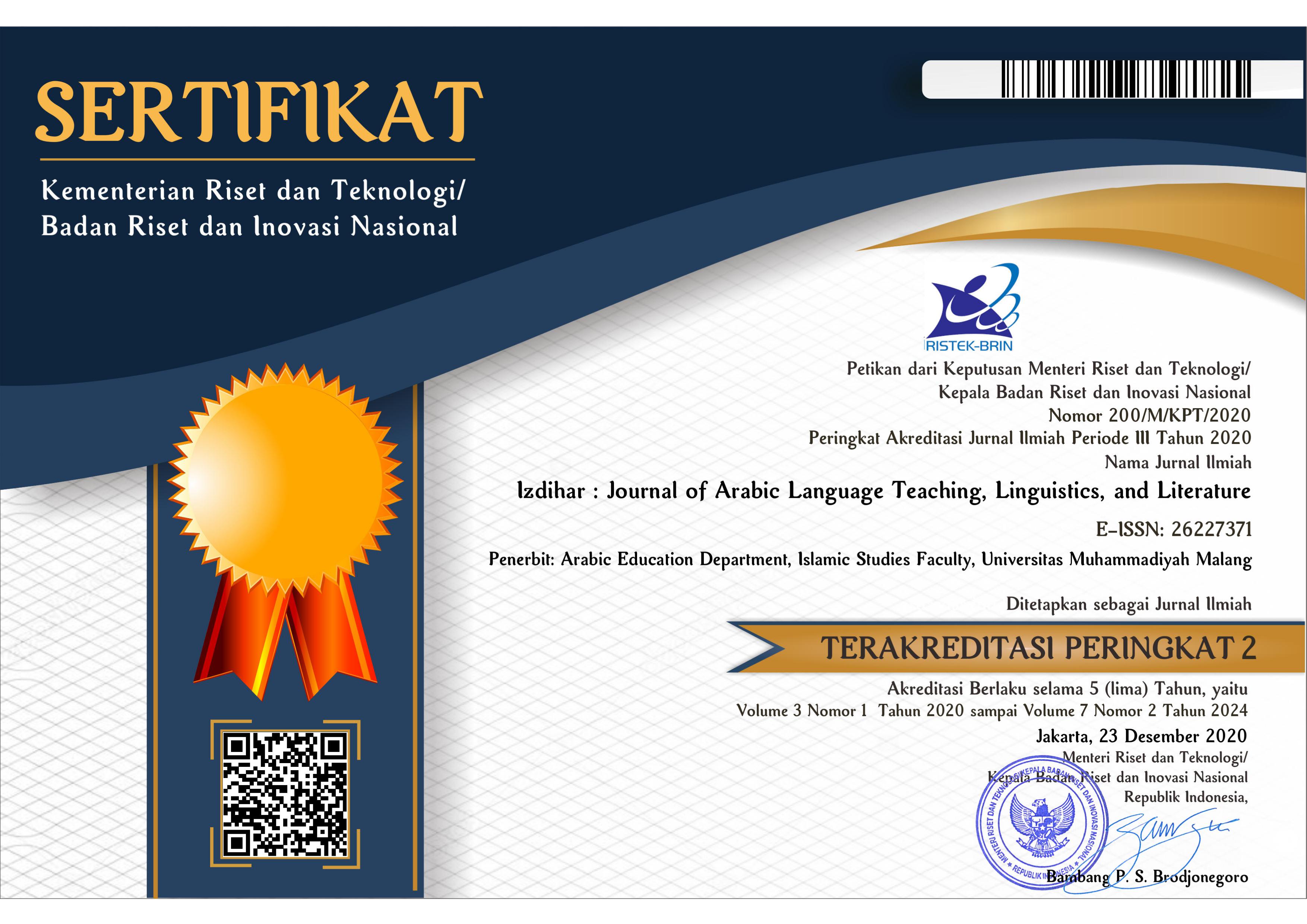CEFR-Based Arabic Language Learning Competency
DOI:
https://doi.org/10.22219/jiz.v3i3.14123Keywords:
Arabic Language, CEFR, Competence, LearningAbstract
Learning Arabic language at CEFR does not only focus on the principles of Nahwu as science or practice, but also there are other competencies that must be included in its learning. This research aimed to formulate an easy and modern Arabic learning method for non-Arabic speakers. This research was descriptive qualitative in nature with the primarily data was the study of the Common European Framework of Reference for Language (CEFR). Data analysis was carried out by document analysis on the CEFR-based Arabic learning competency and the results were presented in descriptive form. This research resulted two main competency standards in teaching Arabic based on CEFR, they were: language competence in general and communicative language competence. In this general competency there were four derivative competencies, namely: 1) declarative knowledge; 2) expertise and skills; 3) existential competence; and (4) the ability to learn. Meanwhile, the CEFR only defined communicative language competence in its three derivative competencies, namely: 1) linguistic competence; 2) sociolinguistic competence; and 3) pragmatic competence.
Downloads
References
Afifah, N., Fauzi, M. F., Anindiati, I., & Nurdianto, T. (2020). The Implementation of Mimicry Memorization Method for Novice Students in Learning Arabic Mufradat. Jurnal Al Bayan: Jurnal Jurusan Pendidikan Bahasa Arab, 12(2), 263–280. DOI: https://doi.org/10.24042/albayan.v12i2.5953
Al-Fauzan, A. bin I., Husein, M. ath-T., & Fadhl, M. A. K. M. (2014). Al Arabiyyah baina yadaik: Silsilatun fî ta’lîm al-lughoh al-‘arobiyyah li ghoir an-nathiqin biha. Riyadh: Mu`assasah al-Waqf al-Islami Riyadh.
Amirudin, N. (2017). Problematika Pembelajaran Bahasa Arab. TAMADDUN, 1–12. DOI: http://dx.doi.org/10.30587/tamaddun.v0i0.66
Astawa, I. N. (2011). Pengajaran “english for guiding” berbasis pendekatan sosiokultural. Jurnal Santiaji Pendidikan (JSP), 1(2), 170–178. DOI: https://doi.org/10.36733/jsp.v1i2.481
Aufa, F. M. (2018). AL-MADKHOL AL-MA’RIFY DAN PEMBELAJARAN BAHASA ARAB. Lisanan Arabiya: Jurnal Pendidikan Bahasa Arab, 2(02), 173–190. DOI: https://doi.org/10.32699/liar.v2i02.649
Dewi, P. D. (2016). Pengembangan buku ajar pemula bahasa Indonesia bagi penutur asing berbasis CEFR. Jurnal Tarbawy, 3(2), 21–40.
Ediyani, M. (2016). Analisis Materi Pembelajaran Bahasa Arab Pada Buku Al-Lughah Al-‘Arabiyah Al-Mu’âshirah Dengan Pendekatan Asas Pengembangan Materi. Al Mahāra: Jurnal Pendidikan Bahasa Arab, 2(1), 109–122. DOI: https://doi.org/10.14421/almahara.2016.021-06
Ediyani, M., Anwar, K., Husaini, H., Zuhaimi, R., & Hidayat, T. (2020). The Analysis of Arabic Learning Materials in Al-‘Arabiyah Baina Yadaik Book with the Principle of Material Development Approach. Budapest International Research and Critics Institute (BIRCI-Journal): Humanities and Social Sciences, 3(2), 965–974. DOI: https://doi.org/10.33258/birci.v3i2.924
Fauzi, M. F., & Anindiati, I. (2020). E-Learning Pembelajaran Bahasa Arab. Malang: UMM Press.
Fitriyah, T., & Fauzi, M. F. (2020). Improving Quality of Arabic Translation Course through Jigsaw Cooperative Learning. Izdihar: Journal of Arabic Language Teaching, Linguistics, and Literature, 3(1). DOI: https://doi.org/10.22219/jiz.v3i1.11033
Habibah, N. (2016). Lingkungan Artifisial dalam Pembelajaran Bahasa Arab. Arabiyat: Jurnal Pendidikan Bahasa Arab Dan Kebahasaaraban, 3(2), 173–196. DOI: https://doi.org/10.15408/a.v3i2.4038
Hamdan, M. (2019). Konstruktivisme Pembelajaran Bahasa Arab Komunikatif. Prosiding Konferensi Nasional Bahasa Arab, 5(5), 132–140.
Haniah, H., Hidayat, S., & Garancang, S. (2019). Al Kitab Al Dirasi Al’Arabiyah Baina Yadaik. (الطموحات) EL-THUMUHAT, 2(1), 25–37. DOI: https://doi.org/10.25299/elthumuhat.2019.vol2(1).2521
Hasibuan, F. H., Nasution, K., & Rahimah, R. (2020). Afiks Derivasi Dan Afiks Infleksi Padanomina Bahasa Arab Dalam Buku Al-Arabiyah Baina Yadaik. Kode: Jurnal Bahasa, 9(1), 29–40. DOI: https://doi.org/10.24114/kjb.v9i1.16938
Khasanah, R. (2018). Kerangka Pengajaran Bahasa Asing Level A1-A2 Dalam Standar Cefr (Studi Pendekatan Filsafat Bahasa). Tesis. Yogyakarta: Program Magister pendidikan Bahasa Arab Fakultas Ilmu Tarbiyah dan Keguruan UIN Sunan Kalijaga.
Muradi, A. (2014). Pendekatan komunikatif dalam pembelajaran bahasa arab. Arabiyat: Jurnal Pendidikan Bahasa Arab Dan Kebahasaaraban, 1(1), 29–48.DOI: https://doi.org/10.15408/a.v1i1.1129
Nikmah, K. (2019). Meaning Variations of Qāla (قال) in Indonesian Language. Izdihar: Journal of Arabic Language Teaching, Linguistics, and Literature, 2(2), 77–100. DOI: https://doi.org/10.22219/jiz.v2i2.9909
Nurdianto, T. (2020). Kompetensi Dasar pembelajaran Bahasa Arab, Common European Framework of Reference (CEFR). Yogyakarta: Zahir Publishing.
Nurdianto, T., & bin Ismail, N. A. (2020). Pembelajaran Bahasa Arab Berbasis Common European Framework Of Reference For Language (CEFR) Di Indonesia. Al Mahāra: Jurnal Pendidikan Bahasa Arab, 6(1), 1–22. DOI: https://doi.org/10.14421/almahara.2020.061.01
Nurdianto, T., Hajib, Z. A., & bin Ismail, N. A. (2019). Educational Objectives The skill of writing Arabic to other speakers at the level of A1 and A2 in perspective of the common European framework for teaching languages. LISANUDHAD, 6(2), 1–36. DOI: https://doi.org/10.21111/lisanudhad.v6i2.3195
Pransiska, T. (2018). BUKU TEKS AL-LUGHAH AL-‘ARABIYAH AL-MU’ĀSHIRAH BAGI PENUTUR NON ARAB Desain, Kontruksi dan Implementasi. Al-Fikra: Jurnal Ilmiah Keislaman, 17(1), 1–20. DOI: https://doi.org/10.24014/af.v17i1.5123
Prayitno, H. J. (2015). Tindak kesantunan berbahasa dalam dialektika pembelajaran pragmatik: Berdaya, berorientasi, dan berstrategi kesantunan positif. PROSIDING PRASASTI, 24–35.
Rahardi, R. K. (2019). Integrating social, societal, cultural, and situational contexts to develop pragmatics course learning materials: preliminary study integrasi sosial, sosial, budaya, dan konteks situasional untuk mengembangkan materi pembelajaran pragmatik: studi.
Santrock, J. . (2012). Life-span development. Chicago: Brown & Benchmark.
Sanz, E. G. (2018). Reseña: Common european framework of reference for languages: Learning, teaching, assessment. Companion volume with new descriptors. MarcoELE REVISTA DE DIDÁCTICA, (26), 1.
Sardila, V. (2016). Strategi Pengembangan Linguistik Terapan Melalui Kemampuan Menulis Biografi dan Autobiografi: Sebuah Upaya Membangun Keterampilan Menulis Kreatif Mahasiswa. An-Nida’, 40(2), 110–117. http://ejournal.uin-suska.ac.id/index.php/Anida/article/view/1500
Schulz, E. (2012). Bahasa Arab Baku dan Modern; Al-Lughah al-‘Arabiyah al-Mu’âshirah. Yogyakarta: LkiS.
Setyawan, C. E. (2015). Pembelajaran Qawaid Bahasa Arab Menggunakan Metode Induktif Berbasis Istilah-Istilah Linguistik. Journal Al-Manar, 4(2). 81-95. DOI: https://doi.org/10.36668/jal.v4i2.54
Syahid, A. H. (2015). Bahasa Arab sebagai bahasa Kedua (Kajian Teoretis Pemerolehan Bahasa Arab pada Siswa Non-Native). Arabiyat: Jurnal Pendidikan Bahasa Arab Dan Kebahasaaraban, 2(1), 86–97. DOI: DOI: https://doi.org/10.15408/a.v2i1.1797
Tajuddin, S. (2017). Pengembangan Model Pembelajaran Bahasa Arab Tingkat Sekolah Dasar Untuk Meningkatkan Kemampuan Berbahasa Arab Siswa. Parameter: Jurnal Pendidikan Universitas Negeri Jakarta, 29(2), 200–215. DOI: https://doi.org/10.21009/parameter.292.08
Zulhanan, Z. (2014). Model Pembelajaran Bahasa Arab Komunikatif. Jurnal Al Bayan Jurnal Jurusan Pendidikan Bahasa Arab , 6(2), https://www.neliti.com/publications/73690/model-pembelajaran-bahasa-arab-komunikatif
Downloads
Published
Versions
- 2021-01-27 (3)
- 2021-01-27 (2)
- 2020-12-31 (1)
How to Cite
Issue
Section
License
Copyright (c) 2020 Talqis Nurdianto

This work is licensed under a Creative Commons Attribution-ShareAlike 4.0 International License.
Copyright Notice
Authors who publish with this journal agree to the following terms:
- Authors retain copyright and grant the journal right of first publication with the work simultaneously licensed under a Creative Commons Attribution-ShareAlike 4.0 International License that allows others to share the work with an acknowledgment of the work's authorship and initial publication in this journal.
- Authors are able to enter into separate, additional contractual arrangements for the non-exclusive distribution of the journal's published version of the work (e.g., post it to an institutional repository or publish it in a book), with an acknowledgment of its initial publication in this journal.
- Authors are permitted and encouraged to post their work online (e.g., in institutional repositories or on their website) prior to and during the submission process, as it can lead to productive exchanges, as well as earlier and greater citation of published work (See The Effect of Open Access).
Copyright (c) 2019 Izdihar : Journal of Arabic Language Teaching, Linguistics, and Literature

This work is licensed under a Creative Commons Attribution-ShareAlike 4.0 International License.

















